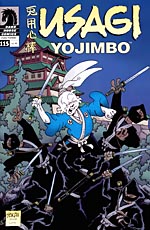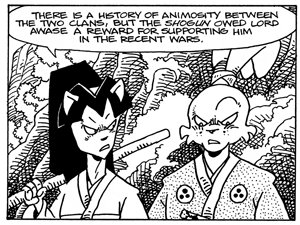 By Stan Sakai
By Stan Sakai
24 pages, black and white
Published by Dark Horse
One comic that I think the industry takes for granted is Stan Sakai’s Usagi Yojimbo. Running since 1984, Sakai’s shogunate era samurai drama is so consistently well-written and drawn that I think people just automatically expect and assume that it will be great as always. Reading the latest two issues, for instance, is a strong reminder of just how Sakai’s series is able to remain so creatively strong.
 Miyamoto Usagi is continuing his wanderings across the land, encountering friends and foes alike. But what starts off as a seemingly normal encounter with a beggar searching for food rapidly becomes much more, with the dreaded Neko ninja clan resurfacing and enacting their latest plan. But is it too late for Usagi to stop the Neko clan once and for all?
Miyamoto Usagi is continuing his wanderings across the land, encountering friends and foes alike. But what starts off as a seemingly normal encounter with a beggar searching for food rapidly becomes much more, with the dreaded Neko ninja clan resurfacing and enacting their latest plan. But is it too late for Usagi to stop the Neko clan once and for all?
One of the things that I’ve always liked about Usagi Yojimbo is how Sakai’s able to incorporate Japanese cultural lessons (so to speak) within the pages of his comic without making you feel like he’s lecturing you. I’d certainly never heard of the specific governmental position that one of the characters in these issues has, for instance, and I certainly appreciated the new information. The comic doesn’t come to a screeching halt to explain it, though, and it’s information that is ultimately at the center of the story. It would certainly be easy for Sakai to have either breezed by the information entirely, or to have made an even bigger deal about it, but instead we learn just the right amount through Usagi’s conversations once the reveal is made.
Sakai’s also very good at making what appears to be a small moment in his comics turn out to be so much more. When I first read Usagi Yojimbo #114, I felt like it was another one of Sakai’s well-told, stand-alone stories. Certainly, if you read "The Beggar" all by itself you’ll end up with a satisfying story that doesn’t require any other knowledge or adventures to feel like you’ve gotten a beginning, middle, and end. At the same time, though, the events of "The Beggar" spill into Usagi Yojimbo #115’s "The Fortress." It was at that point where I really felt Sakai had done such a good job of juggling the needs of so many different readers at once. "The Fortress" will, like "The Beggar," be a good read to anyone who picks up that issue entirely on its own and hasn’t read anything else.  For people who have read the previous story, though, you can see how the two events connect with each other as part of a greater series of events. Even better, long-time fans of Usagi Yojimbo who are familiar with the Neko ninja clan will get even another level out of the story as an old enemy makes another return. There’s excitement and drama and tension for everyone, but what sparks these feelings end up being slightly different things depending on how familiar with Usagi Yojimbo you are.
For people who have read the previous story, though, you can see how the two events connect with each other as part of a greater series of events. Even better, long-time fans of Usagi Yojimbo who are familiar with the Neko ninja clan will get even another level out of the story as an old enemy makes another return. There’s excitement and drama and tension for everyone, but what sparks these feelings end up being slightly different things depending on how familiar with Usagi Yojimbo you are.
Sakai’s art is, as always, very strong. It says a lot that a comic about bipedal animals (instead of people, although there are some people in the mix) can look so very human and simultaneously like the creatures they’re based off of. Usagi’s face is incredibly expressive under Sakai’s pen, from surprised to showing a grim understanding of the events around him. The entire page always looks immensely rich as well, with carefully cross-hatched shadings to help give backgrounds more texture, but applied with great care and never looking rushed. His action sequences are good, too; there’s a large battle scene in Usagi Yojimbo #115 that flows across the page very smoothly and easily. With such a large number of characters it could have been easy for a reader to get lost and confused on what was happening, but Sakai is able to keep it very understandable while never losing sight of the size of both forces in the fight.
Usagi Yojimbo is a real gem of the comics industry, continually plugging forward and telling good, strong stories. My only complaint is a simple one—I do wish we’d get the collections a little swifter. They’re currently running a little over two years behind the monthly comic, and I can’t help but think that if readers could get even a little closer to being caught up with the collected format (say, only one year behind?) the urge to find out what happens next might be strong enough that they’ll just have to pick up the monthly issues as well. And let’s face it, when the only complaint is that you want more Usagi Yojimbo on the shelves? I guarantee, if you read one Usagi Yojimbo story, you’ll want to all the rest. It’s just that addictively good.
